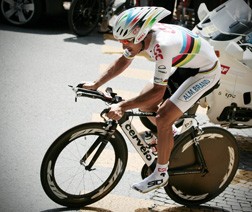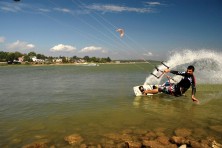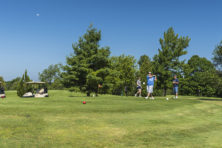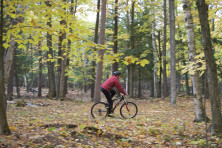Silent Sports: An everyman’s buyer’s guide
- Share
- Tweet
- Pin
- Share

Fabian Cancellara wearing an aero helmet and riding a time-trial bicycle with aerodynamic wheels and aero bars.
In the world of silent sports, no one has all of the gear. There are always better bike parts, newer shoes or a more expensive paste for getting a wetsuit off quickly (I simply prefer Vaseline).
Between registration fees, transportation and lodging, and the extra food costs associated with an extra 1,000 calories burned every day, we are already talking about an expensive activity. So where can we draw the line on what an athlete needs to buy versus what they want to buy?
I look at this question under the idea of buying speed. This concept deals with the equation of where money is best spent and it is correlated with an athlete’s ability and fitness. In general, as an athlete gets more competitive, they will benefit more from the high tech gear. Someone who gets off the couch to run his or her first 5k does not need a pricey heart rate monitor and the shoes worn by an Olympic marathoner.
I will use aero helmets to highlight this example. Aero helmets are the pointy bike helmets that look like bird beaks off the back of a rider’s head. They help with making a cyclist more aerodynamic, cutting down on wind resistance to make riding against the wind easier. These helmets typically range from $150-$300. The one I purchased advertised 40 seconds off of a 40-kilometer (25-mile) bike time.
As a competitive triathlete, 40 seconds can mean the difference between standing on top of the podium and walking straight to my car after a race.
In the Door County Sprint Triathlon in 2014, I lost first place by seven seconds. When you race for first place, every second matters and it is easier to justify the costs of good equipment. Buying speed is a good investment.
For my mother, who impressively picked up the sport of triathlon upon turning 50, buying 40 seconds of speed would earn her one spot in the middle of the pack for the female 50-54 age group. For the recreational athlete, that may not be worth a $300 helmet.
In my racing, I see many athletes who would benefit more from an extra 30 minutes of training each week than the lightest bike chain on the market.
Amateurs and professionals alike will benefit more from focusing on their own engine and considering free speed like a tighter training plan or better nutrition.
My professional triathlete friend, Alex Libin, explained it best when he told me, “If you put a beater 1995 Chevy engine in a brand new Maserati, it’s still a crappy car.”




